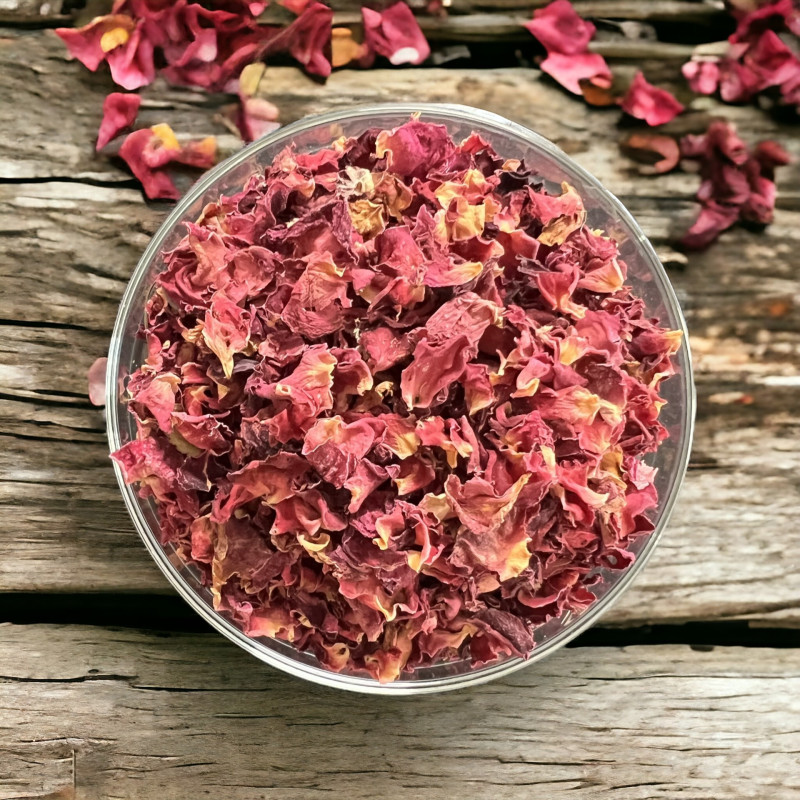
Reference: bleuet


These red rose petals are perfectly natural in color with a very gentle fragrance.
They make a stunning decoration and are also delicious in tea, as an infusion, in North African meatballs, as a salad garnish, or to add flavor to pastries.
 Delivery
Delivery
Mondial Relay
 Returns
Returns
See conditions
 Payments
Payments
100% secure
Livré en sachet refermable
°°°
Uses in Cooking and Beyond:
These petals come from naturally red roses. Their natural beauty makes them ideal for decorative uses: in potpourris, various crafts, as a garnish for dishes or salads, and as table decor. But they have much more to offer!
Flavor-wise, I have a slight preference for the scent of pink rosebuds, yet these red rose petals have a soft, floral, and sweet fragrance that naturally suits culinary uses. Unlike rosebuds, they don’t have any hard parts, making them easier to incorporate into sweet and savory dishes, such as couscous meatballs, without additional preparation. Try adding them to mint tea for a surprising twist!
They are also delicious when used to flavor meringues, ice creams, and various sweet treats, especially when ground into powder. Mixed whole into salads, they add a charming touch that will delight your guests!
A fun use is placing a few petals in the water for ice cubes: once in the glass, the melting ice will release the petals into the drink for a stunning effect!
You can also mix them with other flowers, like cornflower, to make gentle facial lotions. While short-lived, they are completely natural, with no additives or preservatives.
In infusions, without added tea, rose petals and buds have calming effects and aid sleep.
And for a unique idea, they can be tossed at weddings as a replacement for rice, adding a fragrant and colorful celebration!
Who Am I?
Origin: Pakistan
Scientific Name: Rosa damascena
Synonyms: French Rose, Provins Rose, Apothecary's Rose
These petals come from a variety of ancient roses. The rosebush itself originates from Central and Southern Europe as well as Asia Minor, from Turkey to the Caucasus.
The plant reaches around 2 meters in height, with hairy stems covered in many thorns. Many garden varieties stem from this wild species, showcasing colors from rare white to deep red. This non-remontant rose blooms only once a year, with the manual harvest occurring in late spring.
Fresh flowers are widely used to produce an aromatic substance called "rose absolute," still found in many famous perfumes. It takes about 3 million flowers, all hand-picked, to produce just one liter of essential oil!
A Little History:
One of the oldest cultivated rose species, it was known to the ancient Greeks and Romans and was common in medieval gardens.
In antiquity, rose essential oil was as precious as gold. In the East, the elite would pay fortunes for this magical fragrance, due to the vast number of flowers required to produce the oil. By the 19th century, it was among the most important cultivated rose species, and most modern European rose cultivars contain some genes from Rosa gallica.
Its introduction to Europe is credited to Robert de Brie, who is said to have brought it from Persia to Provins around 1254 after the Crusades. Since then, this city has remained the rose capital, from which it spread across the West.
Data sheet
Reference: bleuet
Reference: jasmin
Reference: camomilleRom
Reference: bleuet
Reference: 408190301
Reference: jasmin
Reference: mauve
Reference: rosepetale
Reference: souci
Reference: 112390010
Reference: 10M6810601
Reference: 26545D

These red rose petals are perfectly natural in color with a very gentle fragrance.
They make a stunning decoration and are also delicious in tea, as an infusion, in North African meatballs, as a salad garnish, or to add flavor to pastries.